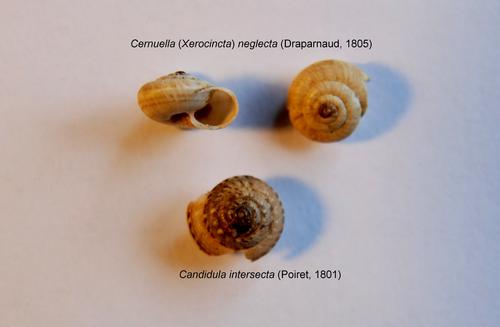South European hygromiid snail shells introduced to Worcestershire in wild bird seed: a potential hazard for the biological record
Paul F. Whitehead
Moor Leys, Little Comberton, Pershore, Worcestershire WR10 3EH email: paul@thewhiteheads.eu
During January 2013 I observed shells of terrestrial snails in wild bird seed mix that I feed to birds in my garden. The seed mix contains seed sourced from both Britain and France. In particular, seeds of Red Dari Sorghum bicolor (L.) Moench, a vigorous coarse grass, are sourced mostly from south-west France in the department of Haute-Pyrénées where over 55000 ha of lower-lying land is given over to the production of grasses and cereals.
Four snail shells were found comprising three Cernuella (Xerocincta) neglecta (Draparnaud, 1805) and one Candidula intersecta (Poiret, 1801) (Fig. 1). A dead Firebug Pyrrhocoris apterus (L., 1758) (Hem., Pyrrhocoridae) was also noted, all having crossed the English Channel passively. The snails are both recognised xerophiles occurring in dry, open, insolated sites, including cultivated fields in southern France although they are highly unlikely to survive processing and transportation of the sorghum seed.
Candidula intersecta is widespread in Britain, becoming coastal north of Yorkshire, but C.neglecta is not a native British species. However, it is a recognised grain pest species which like many hitherto 'Mediterranean' invertebrates has been steadily expanding its range northwards in recent years (Říhová et al 2011)) especially through human activity. These findings create a need for particular awareness amongst students of invertebrates lest the shells are subsequently encountered as isolated finds on the ground leading to possible confusion as to their origin.
Reference
Říhová D., Peltanová, A & Juřičková, L., 2011. Is the Dune Snail Cernuella neglecta (Draparnaud, 1805) spreading in the Czech Republic? Malacologica Bohemoslovaca 10:45-47.
Footnote: use of the name 'Dune Snail' highlights the limitations of vernacular names as there are a number of snails with very similar shells that live on sand and sand dunes.
Image
Fig. 1. Snail shells of Cernuella neglecta (top) and Candidula intersecta from wild bird seed, Little Comberton, Worcestershire, January 2013
